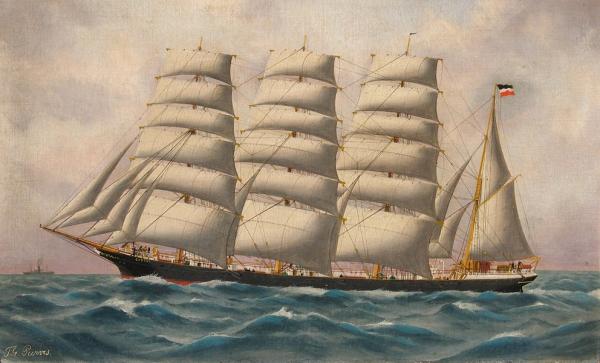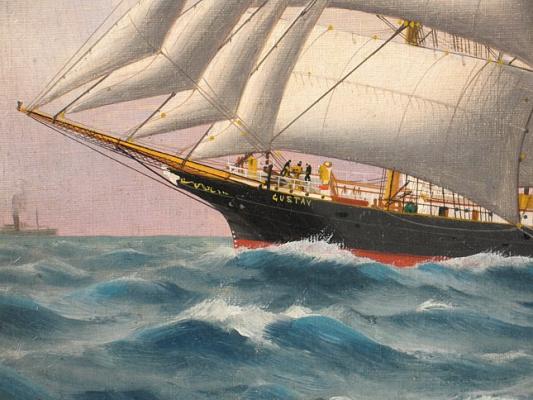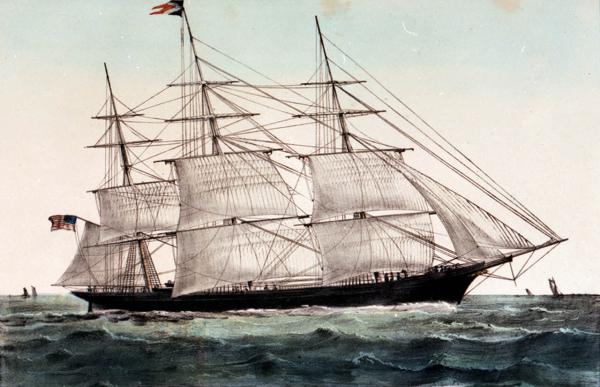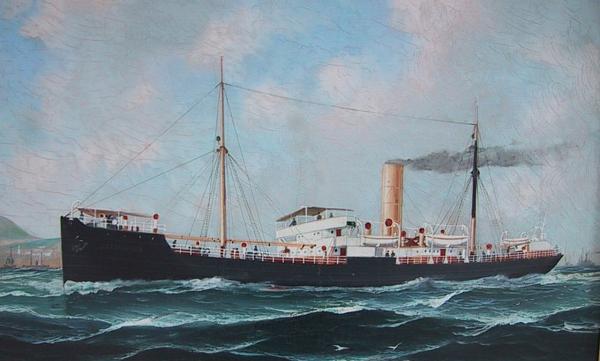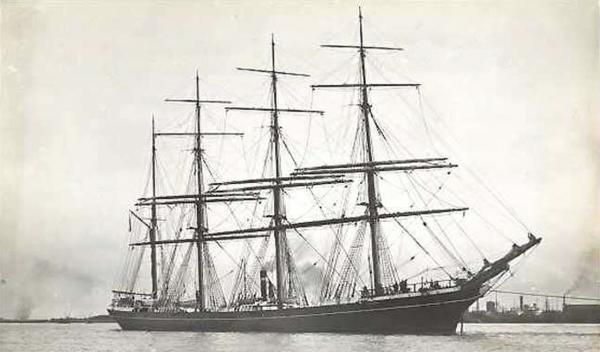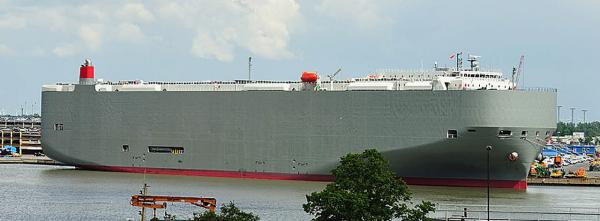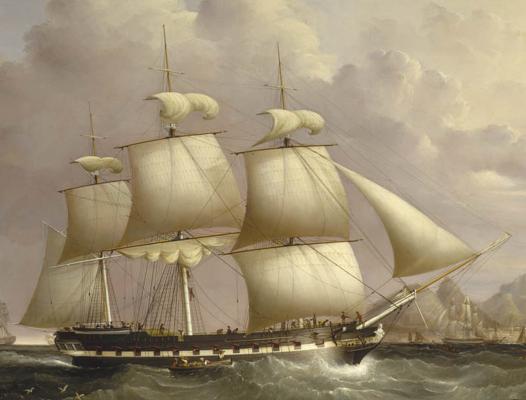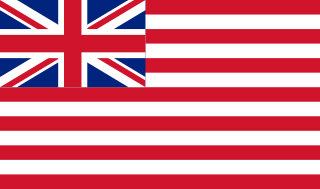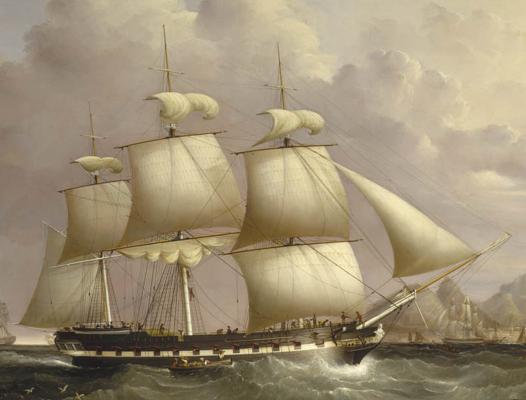-
Posts
455 -
Joined
-
Last visited
Content Type
Profiles
Forums
Gallery
Events
Everything posted by molasses
-
Kenilworth (1887) after being re-rigged as a barque matches the sail plan of the mystery ship, but was described as flush-decked. Sold to Alaska Packers Association and renamed Star of Scotland in 1908. Sold and renamed Rex and used as a gambling ship off Santa Monica, CA in 1938. Sold and re-rigged as a six-masted schooner in 1941, re-named Star of Scotland in 1942. Sunk by U159 later that year.
-
Here's a painting of Gustav the ex-Austrasia in 1910. Built in 1892, sold and renamed Gustav then sold again in 1927 and renamed Melbourne. She was run down and sank with the loss of 10 of her 25 man crew. The captain of MT Seminole was found at fault for failing to yield the right of way to a sailing ship. I know that this history doesn't match with the clues given but the painting is a match for the one presented even to the two life rings on the taffrail. close-up of the name on the bow. Confusing, ain't it? Dave
-
North Star (1892) / Alsterufer (1898) / Suzanne Vinnen (1912) / Carrabin (1915), sunk 1 October 1917 by U96 fits your clues but I can't verify that North Star's sail plan fits the image. I did find this image identified as the three-masted barque Trade Winds (originally Ophia according to the auction company), clearly a mistake. The auction company claimed documented provenance on the painting but the mistakes noted compared to the known facts below cast doubt on it. After all, how can anyone depend on a provenance researcher who clearly can't even count to four. The auctioneers also claimed that Trade Winds set a record carrying tea from Calcutta to London under the command of a Captain Le Patourel (1878-1953) in the late 19th century - at the age of 21 if the passage occurred in 1899 - which I find extremely improbable. The Trade Winds (1891) four masted barque fits the sail plan (courses, double topsails and topgallants, and royals) of the image. She was sold to a German company and renamed Magdelene in 1899 and re-sold and re-renamed Ophelia in 1913. After WW1, she went into the nitrate trade and was broken up in 1923. She did set a record carrying 3100 tons of salt from Hamburg to Calcutta in 107 days in 1892 under the command of Captain Ritchie. There is no mention of a Captain Le Patourel in her records.
-
Queen of Clippers is correct, David. Here's an article that appeared in a Boston newspaper (where she was built and outfitted) shortly before she sailed to New York to take on her first cargo and passengers: http://www.bruzelius.info/Nautica/News/BDA/BDA(1853-04-02).html She was sold to a French company with her name translated into French in 1856. Nothing else is known about her after that. You turn, David.
-
This American extreme clipper (not Flying Cloud) made her maiden voyage in 1853 from New York to San Francisco. Her designer, builder and owners had very high expectations for her but she failed to meet her anticipated top speed of 20 knots or to set any speed records. At almost 2400 tons she was one of the largest of the wooden extreme clippers. She disappears from history after she was later sold by her disappointed owners. The image doesn't show that she was rigged to skysails on all three masts. There are many lists of American clippers on the web but she appears on only one of them (that I have found). Good luck!
-
Name the Ship: This image of a hand colored lithograph is untouched other than cropping to remove the name of the ship across the bottom. And it's not another Euphrates. Good luck! Dave
-
It's the Elso/Kosack built in 1880. I couldn't make much sense of the Finnish to English translation I found but the 1902 hit-and-run was mentioned. From what I could make out the captain of Kosack removed the name plates and replaced them with Elno name plates after colliding with a Danish ship and fleeing the scene. Elno Sank after springing a bad leak when the cargo shifted in the hold while racing a four masted schooner in heavy weather in 1925. Dave
-
Amazing guesses but Jason wins. This Euphrates - my fifth - was launched in 1901 and operated under British registry until sold to a Belgian company in 1906. On the night of 22 January 1917, even though clearly marked as a Belgium Relief ship by International agreement and carrying a German pass, she was torpedoed and sank with one survivor out of her crew of 33. This man was picked up a few hours later by the survivors of another ship sunk by the same German sub. These survivors witnessed the sinking of the clearly lighted Euphrates before there own ship was sunk. At least one source claims the Euphrates survivor was picked up by the second ship before it was sunk, but that is incorrect. Officially, this is the last Euphrates I'm going to post - I can't find images of HMS Euphrates, an early 19th Century 36 gun frigate, another HMS Euphrates, an Insect-class paddle wheel gunboat that began operations on the Tigris River in 1834, or the New Bedford whaler that operated for more than 30 years until sunk by CSS Shenandoah during the American Civil War. The Royal Navy ordered, but later cancelled, three other Euphrates-named warships in the 19th and early 20th centuries. There is also the X Press Euphrates, a container ship now in operation. Interestingly, I haven't found any images of ships named Tigris. I must admit that I enjoyed the research but I should get back to work on my Esmeralda instead of scrounging the internet for ships named Euphrates. Your turn, Jason.
-
-
The Belfast Steam Ship Co. Ulster Prince as prepared for war service. Wrecked at Nauplia in Greece in April 1941, while trying to evacuate troops. Stuka dive bombers destroyed her the following day.
-
You're correct, David, it's another Euphrates, the fourth one I've posted. Your turn, David.
-
Time for a hint or three: She was ship-rigged for about the first third of her life. She was sold and had her national registry changed for roughly the last quarter of her life. She was abandoned and sank with her cargo on her last voyage. Don't give up. This ship is not especially obscure, had a long career and can be found on the internet. Dave
-
-
HMS Agincourt, the painting is dated 1882.
-
Euphrates Highway is correct, Jason. Eamonn, don't give away my tricks. I have to admit it's fun to fool Google Image. Your turn, Jason.
-
Not Columbia Highway.
-
It doesn't appear that this ship will be identified so I'll end the frustration. It's the East Indiaman Euphrates, same name as the troopship entered my last time around. She was launched in 1835, the date on the painting by Samuel Walters. She foundered in 1868. Link: http://collections.rmg.co.uk/collections/objects/14803.html Name the Ship: This one should be easier to find. Image retouched to remove the name and owner markings. Also some harbor equipment that extended above the ship (and could be confused as part of her) have been removed. I left the objects that may or may not be a part of the ship (a tower amidship and a crane boom near the bow). Good luck! Dave
-
Not Hindostan. Confirming this is an Honourable East India Company ship. This ship shows all the characteristics of the Blackwall Frigates (except size) and her launch pre-dates the first of them by less than 5 years. This ship has something in common with one of my previous entries in this game, something generally considered unique. Don't give up yet. Dave
-
TJ: The flag is not early Continental Navy. It was proposed for that purpose, but the red and white striped rattlesnake flag with the motto "Don't Tread On Me" was the one most often used. Besides, it was already in use and had been for hundreds of years with the canton reflecting the current English/British flag and with several variations in the number and pattern of stripes. Getting closer! Dave
-
Not Diana or Brooklyn. The same company owned Diana and this ship but Diana was decades earlier. Re-posting the image to this page.
-
-
An alternative to woodfiller is a thick paste of saw dust and wood glue, an old carpenter's trick for filling finishing nail holes.
- 1,144 replies
-
- snake
- caldercraft
-
(and 1 more)
Tagged with:
-
Thank you, Jan, I don't read Dutch so wasn't sure I even had the name right. Name the Ship: Image is cropped and slightly retouched to remove identifying flags. In spite of her appearance she was a commercial vessel. Good luck! Dave
-
It's the tug Holmvik (1916). Found it on a Dutch website, it took me a while to figure out what "sleepboot" means. Dave
-
Kind of jumping the gun, Jan. You are correct, but you should wait for confirmation. Euphrates and her four sisters, built in 1866, could transport up to 1200 troops and families to or from India in 70 days. Serapis once transported the Prince of Wales for a state visit to India in 1875. They all remained in service until the mid 1890's. Jumna continued in service as a coal hulk (C110) until 1922. Malabar became the base ship in Bermuda, renamed HMS Terror. The training base itself became a "stone frigate" named HMS Terror when the ship was sold for breaking in 1918. The dock in Bermuda where Malabar/Terror was anchored was called Malabar. Once you realized the vessel was a troop transport, it was easy. The Euphrates-class was the only class of troopships, all others were individual ships. By WW1, the Royal Navy had subsidized the construction of passenger ships that could be conscripted when needed, a practice that continued through WW2. Of course, troop transportation is now done by air. Back to your ship, Jan, please excuse the interruption.
About us
Modelshipworld - Advancing Ship Modeling through Research
SSL Secured
Your security is important for us so this Website is SSL-Secured
NRG Mailing Address
Nautical Research Guild
237 South Lincoln Street
Westmont IL, 60559-1917
Model Ship World ® and the MSW logo are Registered Trademarks, and belong to the Nautical Research Guild (United States Patent and Trademark Office: No. 6,929,264 & No. 6,929,274, registered Dec. 20, 2022)
Helpful Links
About the NRG
If you enjoy building ship models that are historically accurate as well as beautiful, then The Nautical Research Guild (NRG) is just right for you.
The Guild is a non-profit educational organization whose mission is to “Advance Ship Modeling Through Research”. We provide support to our members in their efforts to raise the quality of their model ships.
The Nautical Research Guild has published our world-renowned quarterly magazine, The Nautical Research Journal, since 1955. The pages of the Journal are full of articles by accomplished ship modelers who show you how they create those exquisite details on their models, and by maritime historians who show you the correct details to build. The Journal is available in both print and digital editions. Go to the NRG web site (www.thenrg.org) to download a complimentary digital copy of the Journal. The NRG also publishes plan sets, books and compilations of back issues of the Journal and the former Ships in Scale and Model Ship Builder magazines.



